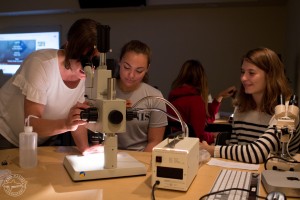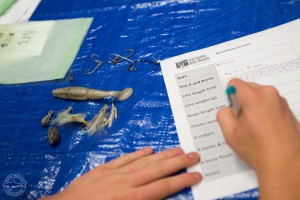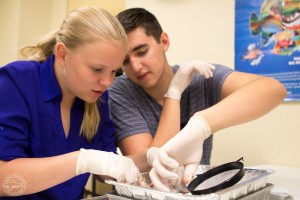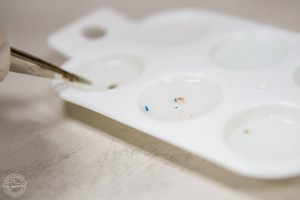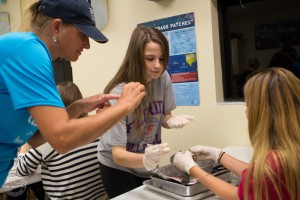High schoolers find hidden plastic in southwest Florida waters, fish
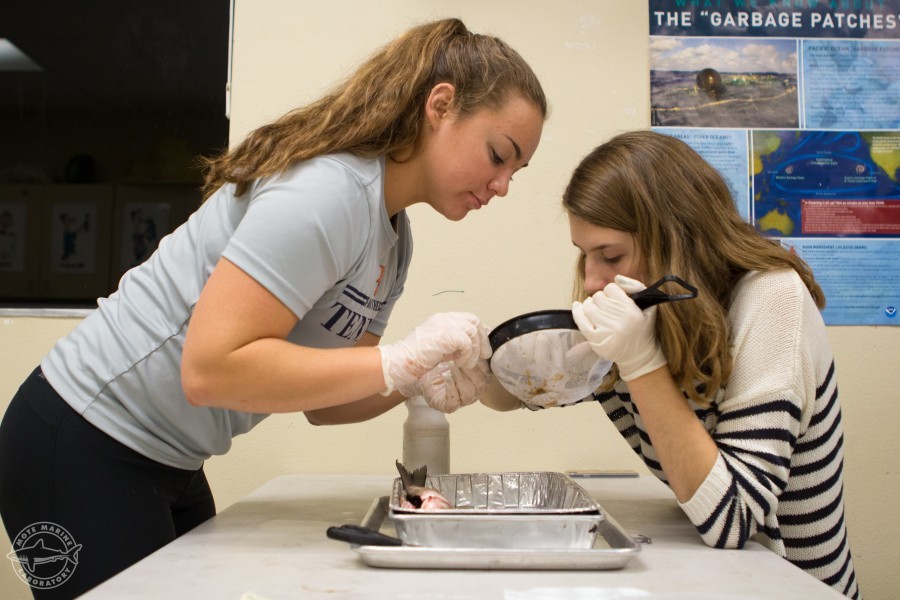
L-R: Mote interns Lily Meadows of and Allison Nahrwold look for microplastics in fish. Credit Conor Goulding/Mote Marine Lab
High schoolers found tiny bits of plastic in southwest Florida waters and fish — local evidence of a worldwide environmental challenge — during Mote Marine Laboratory’s teaching lab with partners from UF/IFAS* Extension’s Florida Microplastic Awareness Project, Sarasota Dolphin Research Program, Sarasota Bay Watch and Palmetto High School on Nov. 15 at Mote’s Sarasota campus.
The teaching lab drew 19 students from Port Charlotte to Tampa Bay schools — members of Mote’s High School Alumni Intern program spanning September 2017-May 2018. Participants have completed a first-year Mote internship and applied successfully for this advanced program.
“These kids are coming together from many different schools and interacting through their passion for marine science,” said Kasey Gaylord-Opalewski, Mote’s Senior Coordinator of Digital Programs, who coordinates Alumni Intern programs with help from a Mote scientist — in this case, Senior Biologist Kim Bassos-Hull. “This year’s program features a focus on marine debris, including microplastics less than 5 centimeters across. The students have been participating in coastal cleanup activities, and tonight they’re taking turns measuring and documenting the fishing line they found, and examining water samples and dissecting fish to check for microplastics.”
Plastic and other trash becomes “marine debris” after falling or washing into the ocean, where it can damage sensitive ecosystems and harm or kill animals that swallow or entangle in it. Derelict fishing gear — such as line, hooks and nets left in the environment — is one growing threat for multiple marine animals around Florida. Meanwhile, consumer plastic products may release or break down into microplastics that sea turtles, birds, fish, shellfish and even corals can mistake for food — potentially with serious health consequences.
The challenge of marine debris will be highlighted in Mote’s upcoming exhibit “Sea Debris: Awareness through Art” featuring “Washed Ashore,” opening Dec. 9. www.mote.org/seadebris
On Nov. 15, several Mote interns started their lab by processing water samples from local environments, using a loudly humming vacuum pump to filter out tiny particles. The interns placed their particle-coated filters under microscopes and systematically scanned them for microplastics using a manual from the Florida Microplastic Awareness Project, a statewide citizen-science program.
“We get data from this,” said Dr. Abbey Tyrna, Water Resources Extension Agent with the UF/IFAS Extension and Sustainability, who led the water filtration activity as a Regional Coordinator for the Florida Microplastic Awareness Project. “The data sheets that the students fill out will contribute to the Project’s database, improving our understanding of distribution and abundance of microplastics around the state.”
Tyrna continued: “Building awareness is key. The kids sampled the water themselves, and it might have looked clean and had fish swimming in it, but we are showing them the hidden world of microplastics. With awareness, they have a chance to help solve this problem.”
Students Emma Harllee and Alex Gregory huddled over their microscope, trying to distinguish natural from human-made particles.
“There’s a big fiber!” said Harllee, a sophomore at Saint Stephen’s Episcopal School.
Gregory, a junior at Florida Southwestern Collegiate High School, checked the manual: “Does it have no cellular structure? Is it equally thick throughout?”
“Yes, yes!” Harllee replied.
Tyrna stepped in: “That would be an excellent candidate for the flame test.” She helped the students expose the fiber to heat from a candle flame to determine whether it would burn, suggesting natural material, or melt, suggesting plastic. This fiber slipped out of the students’ tweezers before they could complete the test, but then they found another.
“This one is such a bright blue that we can tell it’s not natural,” Harllee said.
Of the six 1-liter water samples Mote interns collected between Phillippi Creek and Anna Maria Island, four contained microplastics. Most of the plastic comprised fibers from synthetic clothing, such as polyester and fleece.
Next door, interns dissected mullet, pinfish, sheep’s head and catfish from southwest Florida waters to check for microplastics in their digestive tracts, with the help of Natalie Richard, currently a marine science and biology teacher at Palmetto High School and master’s degree student at Memorial University, St. Johns, Canada.
“Our group found one piece of plastic in a catfish,” said home-schooled senior Allison Nahrwold. “We learned how to look for it and determine whether it was plastic or not.”
“We got a rundown of microplastic basics when we began this lab two weeks ago, and now this is the real life application of what we learned,” said Garrett Turner, a senior at Cardinal Mooney Catholic High School. “We learned the methodology of looking for these microplastics, which can be less than a millimeter long. If we suspected we found plastic, we put it in water; if it floated, then it was likelier to be plastic and worth checking out more carefully.”
All told, Mote interns examined nine southwest Florida fish, finding that seven had microplastic pieces in their digestive tracts.
Down the hall, other interns took their turn measuring fishing line collected from local marine and coastal environments.
Mote Senior Biologist Kim Bassos-Hull and Sarasota Bay Watch Program Director Ronda Ryan guided the interns on quantifying the amounts of line — some collected during Sarasota Bay Watch cleanup events, and some from bridge and pier surveys by Mote’s High School Intern Program and the Sarasota Dolphin Research Program (SDRP), a Chicago Zoological Society program in collaboration with Mote.
Multiple marine mammals and sea turtles in southwest Florida have died from entangling in or ingesting line. For instance, SDRP reported that one of the oldest dolphins in Sarasota Bay, “Squiggy,” died in 2014 with three large fishing hooks in her stomach and one in her mouth attached to 11 feet of heavy monofilament line.
During the Nov. 15 activities, the Mote interns documented 495 feet of line and 42 pieces of tackle removed from area bridges and piers since Oct. 1. Additionally, they documented 14.1 feet of line and a hook from Phillippi Creek, 126.86 feet of line, four hooks, two swivels and a 7-foot net from Red Bug Slough, and 150.92 feet of line, 160.17 feet of rope, 270 swivels and one net from Sarasota Bay Watch and Suncoast Reef Rovers cleanup at South Jetty.
“I think all three activities this evening have given the interns perspective on what kinds of debris are present in the ecosystem and in the animals,” Bassos-Hull said. “It might help them make more positive decisions about reducing plastic in their own lives.”
Mote’s high school alumni interns will lead a teen coastal cleanup from 8:30-11 a.m. Feb. 10, 2018 on City Island, Sarasota. All teens age 14-18 are invited. Check for details at Mote Events.
Learn more tips and events for reducing marine debris.
--
*University of Florida, Institute of Food and Agricultural Sciences
